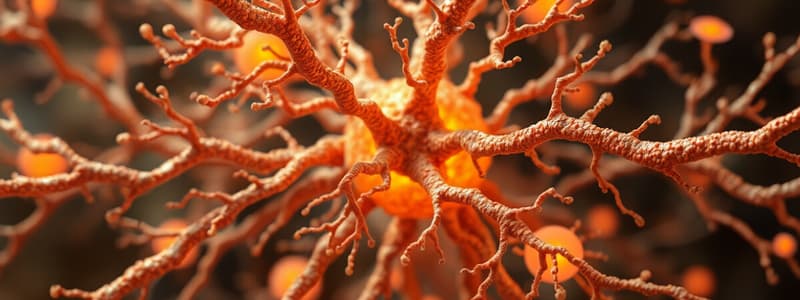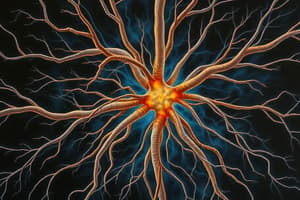Podcast
Questions and Answers
Which of the following glial cells is responsible for maintaining the chemical environment of calcium and potassium in the CNS?
Which of the following glial cells is responsible for maintaining the chemical environment of calcium and potassium in the CNS?
- Astrocytes (correct)
- Schwann cells
- Oligodendrocytes
- Microglia
What is the function of the posterior root ganglia?
What is the function of the posterior root ganglia?
- To carry sensory information from the body to the spinal cord. (correct)
- To carry motor signals from the spinal cord to muscles and glands.
- To regulate the environment around neurons in the PNS.
- To produce myelin in the PNS.
Which of the following is NOT a characteristic of the pia mater?
Which of the following is NOT a characteristic of the pia mater?
- It is the outermost layer of the meninges. (correct)
- It is directly in contact with the spinal cord and brain.
- It helps supply nutrients and remove waste with blood vessels.
- It is thin and delicate.
Which type of neuron is characterized by a fused axon and dendrite that emerges from the cell body as one unit?
Which type of neuron is characterized by a fused axon and dendrite that emerges from the cell body as one unit?
What is the primary function of the white matter of the spinal cord?
What is the primary function of the white matter of the spinal cord?
Which type of neuron is responsible for conducting impulses from sensory receptors to the central nervous system?
Which type of neuron is responsible for conducting impulses from sensory receptors to the central nervous system?
What is the primary function of the myelin sheath in neurons?
What is the primary function of the myelin sheath in neurons?
What role do Schwann cells play in the peripheral nervous system?
What role do Schwann cells play in the peripheral nervous system?
Which structure of a neuron is responsible for receiving signals from other neurons?
Which structure of a neuron is responsible for receiving signals from other neurons?
What describes the function of myelin sheath gaps, also known as nodes of Ranvier?
What describes the function of myelin sheath gaps, also known as nodes of Ranvier?
What role do heat receptors in the skin play in a reflex action?
What role do heat receptors in the skin play in a reflex action?
Which structure is responsible for transporting signals from the integrating center to the effector in a reflex arc?
Which structure is responsible for transporting signals from the integrating center to the effector in a reflex arc?
During the patellar reflex test, what type of movement is typically observed?
During the patellar reflex test, what type of movement is typically observed?
What is the primary purpose of conducting basic reflex tests such as the Achilles tendon reflex?
What is the primary purpose of conducting basic reflex tests such as the Achilles tendon reflex?
What is a characteristic of a reflex arc compared to voluntary muscle movements?
What is a characteristic of a reflex arc compared to voluntary muscle movements?
Flashcards
Sensory neuron
Sensory neuron
The neuron that carries signals from sensory receptors to the central nervous system (CNS).
Interneuron
Interneuron
The neuron that integrates information received from sensory neurons and then transmits it to motor neurons.
Motor neuron
Motor neuron
The neuron that carries signals from the CNS to an effector (muscle or gland).
Dendrites
Dendrites
Signup and view all the flashcards
Cell body
Cell body
Signup and view all the flashcards
Reflex Arc
Reflex Arc
Signup and view all the flashcards
Receptor
Receptor
Signup and view all the flashcards
Integrating Center
Integrating Center
Signup and view all the flashcards
Bipolar Neuron
Bipolar Neuron
Signup and view all the flashcards
Multipolar Neuron
Multipolar Neuron
Signup and view all the flashcards
Oligodendrocyte
Oligodendrocyte
Signup and view all the flashcards
Subarachnoid Space
Subarachnoid Space
Signup and view all the flashcards
Dura Mater
Dura Mater
Signup and view all the flashcards
Study Notes
Nervous System I: Nervous Tissue and the Spinal Cord
- The nervous system is a complex network controlling all body processes.
- It receives, integrates, and initiates reactive measures to maintain homeostasis.
- Homeostasis is the body's ability to maintain a stable internal environment.
- The nervous system has two major divisions: central (CNS) and peripheral (PNS).
- The CNS includes the brain and spinal cord.
- The PNS includes cranial nerves, spinal nerves, ganglia, and sensory receptors.
Structure of Nervous Tissue
- Neurons: The functional units of the nervous system.
- Specialized for impulse conduction.
- Responsible for the nervous system's functions (e.g., thinking, muscle activity).
- Classified into three types based on function: sensory (afferent), interneuron (association), and motor (efferent).
Neuroglia
- The second category of cells in nervous tissue.
- Perform various functions, including structural support, forming myelin sheaths, and maintaining the chemical environment.
Structure of the Spinal Cord
- Protected by the vertebral column.
- Extends from the medulla oblongata to L2 vertebrae.
- Contains: white matter bundles of axons and gray matter (cell bodies and interneurons).
Spinal Meninges
- Three layers of connective tissue surrounding the spinal cord.
- Dura Mater: Superficial, tough, and protective outer layer.
- Arachnoid Mater: Middle layer, composed of collagen and elastic fibers.
- Pia Mater: Deepest layer, adhering to the spinal cord, containing blood vessels.
- Subdural Space: Space between Dura and Arachnoid Mater filled with interstitial fluid.
- Subarachnoid Space: Space between Arachnoid and Pia Mater filled with cerebrospinal fluid.
- Epidural Space: Space between the vertebral column’s bone and the Dura Mater, filled with fat and connective tissues.
Spinal Nerves and Plexuses
- 31 pairs of spinal nerves emerge from the spinal cord, connecting to the PNS.
- Each nerve is a bundle of axons.
- Spinal nerves have anterior and posterior roots, conveying sensory and motor information.
- Posterior roots carry sensory information to the CNS.
- Anterior roots carry motor information from the CNS.
- Rami: branches formed by anterior rami of spinal nerves.
- Plexuses: networks formed by anterior rami that innervate specific body regions.
Reflexes
- Rapid, automatic responses to stimuli.
- Maintain homeostasis.
- Involve five components of a reflex arc: sensory receptor, sensory neuron, integrating center, motor neuron and effector.
- Monosynaptic reflexes: Involve a single synapse between sensory and motor neurons.
- Polysynaptic reflexes: Involve multiple synapses and interneurons.
Reflex Tests
- Clinical diagnostics using reflex tests to evaluate the nervous system.
- Procedures describe for identifying different types of reflexes.
Studying That Suits You
Use AI to generate personalized quizzes and flashcards to suit your learning preferences.




